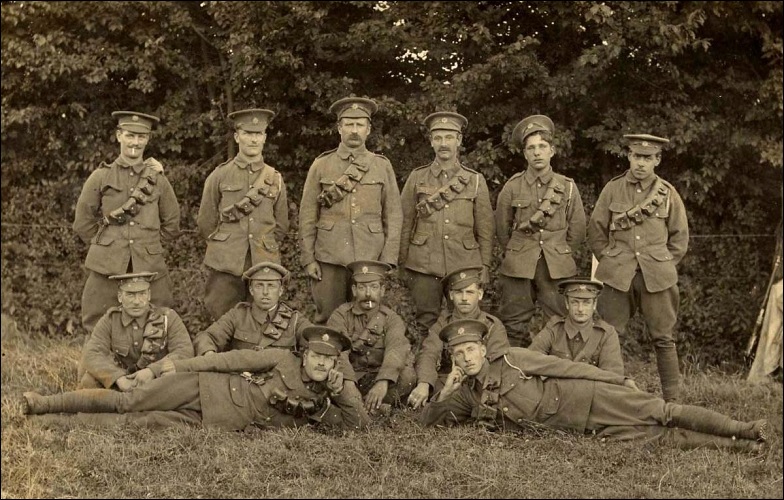● ● ●
For
clarity, German units are rendered in italics.
The 1914 Battle of Flanders was
actually a series of engagements in two areas. Along the
fifteen-mile stretch of the Yser River between the Channel
coast and the vicinity of the village of Oudecapelle, where
the river bends west, the Belgian Army and two brigades of
French marines fought to stop the advance of German
Fourth Army, while in
the vicinity of the town of Ypres the British Expeditionary
Force opposed the advance of Fourth Army’s
left wing and the bulk of Sixth Army.
Between the Belgians and the BEF stood the newly
constituted
French Eighth Army, formerly the
Détachement d'armée de Belgique (Army
Detachment in Belgium).
After the
Battle of the Marne the BEF had been transferred from the
Paris area to Flanders, this to position it closer to its
bases on the Channel coast. As things turned out the British
Army would to fight in Flanders throughout the war,
undergoing an ordeal that has passed into legend. The
fighting in Flanders was rivaled only by the Battle of
Verdun in its exemplary horror; nowhere else on the Western
front was the essence of trench warfare so thoroughly
distilled.
The First Battle of Ypres raged
from mid-October to late November 1914: a month and a half
in which the original British Expeditionary Force was effectively
wiped out. Total British casualties from August to November
1914 were not far short of 90,000—nine-tenths of the
original BEF. Some 60,000 of these casualties—killed,
wounded and missing in action—were inflicted during First
Ypres. For the British, the very name of Ypres thus came to
symbolize the peculiar horrors of trench warfare on the
Western Front: the rain, the mud, the misery, the unceasing
artillery bombardments, the strain, the deadly fatigue, the
ever-present shadow of death.
It has been said that the virtues
and qualities of the Old Contemptibles—the soldiers of the
prewar British Army—rendered inevitable their martyrdom in
Flanders. Regimental loyalty, inarticulate yet deep
patriotism, unthinking courage and sheer stubbornness kept
them positioned in their waterlogged shell holes and
rudimentary trenches, day after day, week after week, in the
face of violent German attacks that stretched the defense to
the breaking point. In the end the line held—but the price
paid was intolerably high. Henceforward a new and different
British Army would fight the war: Territorials, Kitchener
volunteers and conscripts stiffened by the handful of Old
Contemptibles who'd survived the war’s first campaign.
The First Battle of Ypres unfolded
in five stages. As it redeployed to Flanders the BEF (Field
Marshal Sir John French) clashed with German Fourth Army
(Duke Albrecht of Württemberg) and Sixth Army (Crown
Prince Rupprecht of Bavaria) between 19 and 21 October, a
little east and south of the town of Ypres, both sides
seeking to advance. Thereafter the BEF was forced onto the
defensive. Then followed the Battle of Langemarck (21-26
October), the Battle of Gheluvelt (29–31 October), the last
big German push from 5 to
13 November, and finally a series of minor clashes that
gradually petered out by the end of November. As mentioned
above, First Ypres was fought concurrently with the Battle
of the Yser, where the Belgians and French opposed the
advance of German Fourth Army along the Yser
River, terminating on the Channel coast. The French General
Ferdinand Foch coordinated Allied operations and though he
had no formal power of command over the Belgians and
British, he generally was able to secure their cooperation.
His management of the Allied reserves—mainly French—had a
major impact on the outcome of the linked battles along the
Yser and around Ypres.
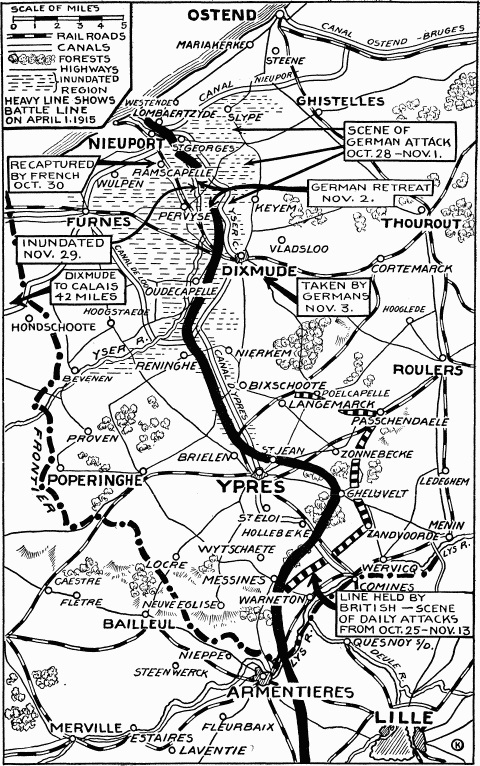
The Yser-Ypres sector of
the Western front: October-November 1914; the heavy black
line delineates the stabilized front at the conclusion of
the battle
The Encounter Battle
First Ypres commenced when advancing German troops
made contact with units of the BEF moving into the Ypres
area. Both sides were intent on an attack to roll up the
enemy’s flak and advance along the Channel coast. The BEF
made some initial progress but was stopped by German
counterattacks, both sides suffering heavy casualties. The
British then went over to the defensive and the Germans
regrouped for a deliberate attack. General Erich von
Falkenhayn, the Chief of the OHL and de facto German
commander-in-chief, sought to deliver a decisive stroke by
means of a major offensive down the Channel coast, capturing
the ports that were so important to the BEF. For this
purpose he reorganized his forces, setting up a new
Fourth Army on the
German right flank to which were assigned eight of the
twelve reserve divisions raised in August and now judged
ready for action. Fourth Army’s
mission was twofold: (1) to cross the Yser River,
annihilating the Belgian Army and driving down the Channel
coast, and (2) to crush the BEF around the town of Ypres,
capturing that town and rolling up the Allied left flank.
Farther south, Sixth Army
would attack with the mission of protecting Fourth
Army’s left flank.
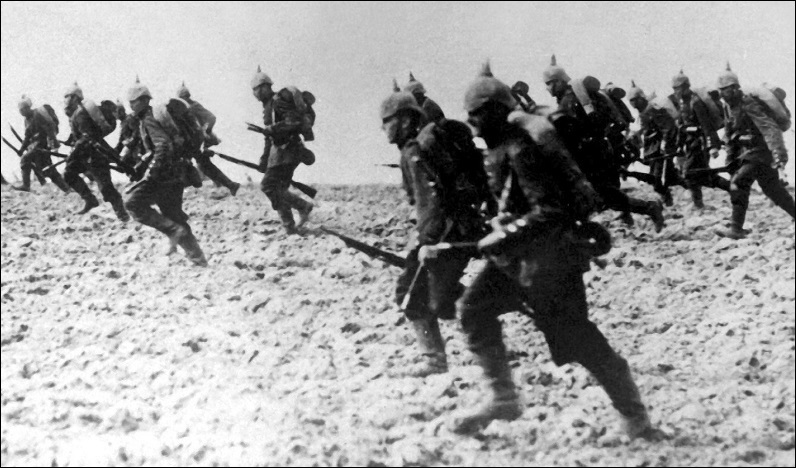
German infantry advances
into battle, 1914 (Bundesarchiv)
The Battle of
Langemarck
The German attack was launched on 21 October and the fighting
came to center around the town of Langemarck, northeast of
Ypres, where XXVI Reserve Corps
of Fourth Army,
attacking with two divisions, sought to smash IV Corps and
an attached French territorial division,
constituting the BEF’s left flank. The German divisions
embodied a large proportion of young volunteers, enlisted at
the start of the war in August, sketchily trained and poorly
equipped. Attacking in dense formation, the Germans were
repeatedly savaged by the defenders’ rifle, machine gun and
artillery fire. But the British too suffered heavily and the
fighting swayed back and forth until the exhausted Germans
broke off their attacks around Langemarck. The battle
entered into legend on the German side as the
Kindermord
(Massacre of the Innocents)—a reference to the heavy
casualties suffered by the young volunteers.
Subsequently the German offensive was renewed farther south, along the Menin Road (25-26
October). Here the British defenses fell apart, but reserves
were brought forward and managed to plug the gap, preventing
a German breakthrough.
The Battle of Gheluvelt
By
26 October, Falkenhayn recognized that his attacks so far
had failed. He therefore ordered Fourth Army
and Sixth Army
to revert to an active defense pending the assembly of a new
attack group. This was Armeegruppe Fabeck
(General of Infantry Max von Fabeck), a temporary formation
consisting of three corps with eight divisions. It was to be
inserted between Fourth Army
and Sixth Army
with the mission of attacking toward Ypres.
Armeegruppe Fabeck
would be supported by XXVII Reserve Corps
of Fourth Army,
attacking toward the Gheluvelt crossroads. Sixth
Army was to stand on the defensive, giving up a
proportion of its heavy artillery to Armeegruppe Fabeck.
The new German offensive commenced
on 29 October, with XXVII Reserve Corps advancing
against the BEF’s I Corps north of the Menin Road. Fog aided
the Germans, who managed to gain the Gheluvelt crossroads by
nightfall, capturing more than 600 British troops in the
process. Farther south, Armeegruppe Fabeck fell on I
Corp’s right flank and upon the BEF’s Cavalry Corps,
fighting as infantry. Here the German attack penetrated to
within two miles of Ypres itself and once again the battle
seesawed back and forth. The timely arrival of three French
battalions and the intervention of “Bulfin’s Force,” a
formation improvised from a miscellany of British service
troops and stragglers, just barely prevented a breakthrough.
But the BEF had no more reserves and the situation looked
desperate, Sir John French believing that his army faced
total defeat. The Germans had also suffered heavily,
however, and after a breakthrough at Gheluvelt on 31 October
was contained by a British counterattack, the battle petered
out.
The Final German Push
Twice now the Germans had come close to rolling up the
Allied line in Flanders and Falkenhayn was determined
to try again. His objectives this time were more modest:
merely to capture Ypres and Mount Kemmel, thus compelling
the British to abandon the Ypres salient. But by now both
sides were close to exhaustion. Fourth Army’s corps
had suffered up to 70% casualties at Langemarck;
Armeegruppe Fabeck had
suffered over 17,000 casualties in five days of fighting. As
for the BEF, it was being bled white. Of its 84 infantry
battalions, each originally 1,000 men strong, 75 now
mustered fewer than 300 men—in some cases fewer than 100
men. Such replacements as arrived in France came nowhere
close to covering the losses suffered. Help did come in the
form of French XVI Corps, which backstopped the BEF’s
hard-pressed Cavalry Corps. The French also conducted
attacks farther north in support of the BEF’s I Corps, which
by now mustered fewer than 10,000 men—less than the strength
of a single division.
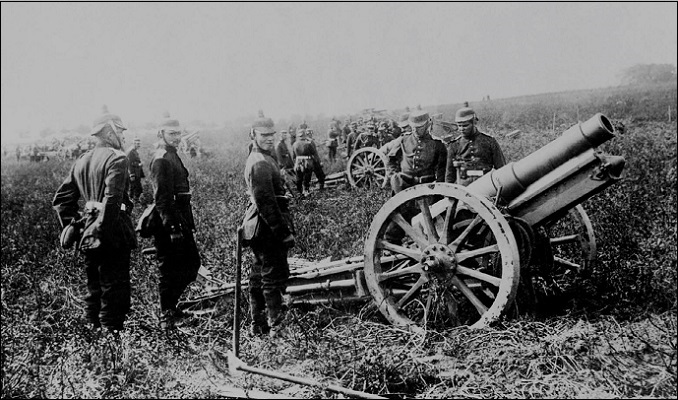
A battery of German 105mm
light field howitzers prepares for action, 1914 (Bundesarchiv)
General Foch, coordinating the
defense of the Allied left flank, planned an attack by
Eighth Army toward Langemarck and Messines, to commence on 6
November. The idea was to take pressure off the BEF by
expanding the Ypres salient, but German attacks on the
flanks of the salient commencing on 5 November derailed the
plan. On 9 November the Germans drove back the French and
Belgians north of Gheluvelt
and on 10 November the main German attack was delivered by
Fourth Army, Sixth Army
and Armeegruppe Fabeck
with thirteen divisions.
The attackers broke through in several sectors including the
vital Menin Road, and once again it looked as though the
British defense would collapse. But heavy casualties, lack
of reserves and sheer exhaustion combined to stall the
Germans when they seemed close to victory, and the British
were able to restore their line.
The Battle Subsides
Mutual
exhaustion and the onset of cold weather brought major
operations in Flanders to an end after 13 November. Along
the Yser River, where the Belgians had opened the sluice
gates controlling the drainage system, flooding low-lying
areas, both sides had become paralyzed. And though the
British remained in possession of Ypres, the prize was a
dubious one. Their line in the vicinity of the town
constituted a relatively narrow salient projecting into
German-held territory, exposed to observation and fire from
front and flanks. That the Germans occupied most of the high
ground in the area only worsened British problems. But
having expended so many lives to prevent the enemy from
capturing the town, the BEF’s commanders could not persuade
themselves that it would be better to evacuate the salient.
Instead they ordered their troops to dig in—ensuring that
Ypres would become a name of ill omen in British military
annals.
Analysis of the Battle
It
may seem inexplicable that so many troops, concentrated in
so small an area as Belgian Flanders, achieved in a month
and a half of violent combat nothing but stalemate. But it
was precisely that concentration of numbers that made
stalemate inevitable. First Ypres demonstrated with crystal
clarity what
earlier battles had strongly suggested: that due to a
combination of factors the defense had gained a decisive
advantage over the attack. Various military thinkers, Carl
von Clausewitz prominent among them, had preached that
defense is the stronger form of war. In 1914, thanks to the
Industrial Revolution with all its attendant political,
social and cultural fallout, the superiority of the defense
in war was maximized. This superiority was distilled into
one deadly element: firepower.
The rifles, machine guns and artillery supplied to the
armies by industry were orders of magnitude more effective
and deadly than anything seen on the battlefield since the
dawn of history. And this superiority benefited the
defenders far more than the attackers—particularly when the
former were fighting from entrenched positions. Even a crude
hole in the ground greatly enhanced the survivability, hence
the effectiveness, of a defending rifleman. And if that hole
sheltered the crew of a machine gun, troops attacking in
dense formations could be shot down in droves.
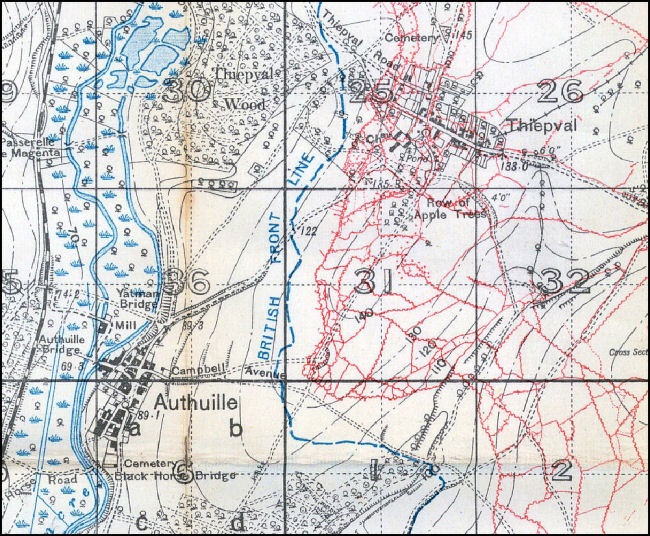
A BEF map showing part of
the Somme sector of the Western Front in late 1915. For
security reasons only the British front line is delineated
in blue, but the complete German trench system is depicted
in red. (McMaster University Libraries, Lloyd Reeds Map
Collection)
Thus the
holes and ditches from which the defenders fought the First
Battle of Ypres were rapidly transformed into complex
entrenched positions, not just in Flanders but all along the
Western Front. Protected by dense belts of barbed wire and
backstopped by artillery, these trench defenses were, if not
absolutely impregnable, extremely difficult to attack. So
began the search for some tactical solution to the
trench deadlock and the obvious one seemed to be more of
what had produced it in the first place: firepower. The
generals told one another and their political masters that
with enough guns and shells, the enemy’s defenses could be
battered down. Much blood was to be spent demonstrating the
simplistic falsity of this idea.
Of
the senior commanders on both sides, it was Erich von
Falkenhayn who drew the
most nearly correct lessons from the Battle of Flanders. He
was now convinced that the strategy pursued so far by
Germany—Vernichtungsstrategie
or annihilation of the enemy—could not succeed. Germany, he
perceived, lacked the strength to score a decisive victory
over any of her foes. While recognizing that in many
respects Russia— economically backward, internally unstable,
its leaders fearful of revolution—was the weak link in the
coalition confronting Germany, he doubted so large a country
could be vanquished by the forces that Germany and
Austria-Hungary were able to muster for the Eastern Front.
Yet no less than his predecessor, Falkenhayn regarded the
Western Front as the main theater of war.
He therefore reverted to
Ermattungsstrategie,
exhaustion of the enemy, a
strategy of attrition that would reach its culminating point
in the Battle of Verdun.
